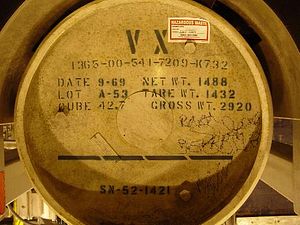On Friday morning, Malaysian police confirmed that Kim Jong-un’s half-brother, Kim Jong-nam, was assassinated with the VX nerve agent at Kuala Lumpur International Airport. North Korea is thought to possess the world’s third largest chemical weapons stockpile after the United States and Russia, with one estimate noting that it may possess 2,500 to 5,000 tons of chemical warfare agents. To date, while VX had thought to be an objective for North Korea’s chemical weapons program, there had been no evidence that Pyongyang possessed the highly dangerous nerve agent.
Kim Jong-nam’s assassination, which took place on February 13, has been surrounded by intrigue and speculation, ranging from the extent to which the North Korean mission in Kuala Lumpur provided direct support to the motivations of the two female assassins involved. Malaysian authorities have held individuals at the North Korean embassy in the country liable for involvement in the attack and the use of VX adds to the growing list of evidence pointing to the fact that this was a state-sanctioned assassination, despite ongoing North Korean denials.
North Korea’s use of VX is especially audacious given that it occurred at a busy international airport. VX is so dangerous that the median lethal dose is estimated at 10 mg. The United States Centers for Disease Control and Prevention notes that “people can be exposed through skin contact, eye contact, or inhalation.” The agent can kill within minutes of making contact with human skin. In Kim Jong-nam’s case, Malaysian authorities noted that the agent was detected in his eyes; chemical nerve agents generally work faster once they’ve made contact with mucous membranes such as those found in the human eye.
Remarkably, no reports have emerged to date of any individuals suffering from the VX use at Kuala Lumpur International Airport on February 13. Both assassins survived to end up in Malaysian custody and Malaysia has not specifically announced if any medical or airport staff who handled Kim Jong-nam’s body fell ill or demonstrated any signs of having come into contact with a deadly nerve agent.
Indeed, one of the remaining mysteries in this case now, with the confirmation of VX use, is how neither of the assassins nor any bystanders appear to have been affected. One possibility — suggested by the use of multiple assassins instead of one — is that a VX binary was used, but this has not been confirmed by Malaysian authorities. In a two-stage binary VX reaction, two otherwise safe precursor compounds synthesize the dangerous nerve agent. Accounts of the Kim Jong-nam assassination — including CCTV footage — have confirmed at least two women approached Kim, one of whom put him in a two-handed chokehold. (The U.S. Army first developed binary nerve agents to enable safer handling and storage.)
North Korea is not party to the Chemical Weapons Convention, but has signed the Geneva Protocol restricting the use of chemical agents in war. According to the Nuclear Threat Initiative, “at maximum capacity, North Korea is estimated to be capable of producing up to 12,000 tons of CW.” For wartime use, South Korea seemingly expects delivery of chemical or biological agents by conventional artillery shells. In 2010, after the shelling of Yeonpyeong Island, fearing chemical use in the future, South Korea handed out gas masks to the island’s residents.
It’s unclear if the Kim Jong-nam assassination was meant to serve the secondary purpose of signaling to the world that North Korea definitively possesses the capability to synthesize VX. Immediately after Kim Jong-nam’s death, North Korea protested Malaysia’s intention to proceed with an autopsy and demanded that the body be transferred to its diplomatic mission. Melissa Hanham, an arms control expert at the James Martin Center for Nonproliferation Studies, told The Diplomat that North Korea’s denials in the press and suspected attempt to even break into the morgue where Kim Jong-nam’s body also add confusion to the situation.
The choice of VX for the assassination, however, isn’t unprecedented. Japanese doomsday cult Aum Shinrikyo used the nerve agent for the 1995 assassination of Tadahito Hamaguchi in Osaka, with VX emerging in the autopsy. Aum Shinrikyo also carried out an attack on the Tokyo subway with sarin, another nerve agent, in 1995, killing 12 and injuring more than 4,000. North Korea has used poison-laced needle attacks in assassination attempts in the past; South Korean authorities reported three such incidents against South Korean activists helping North Korea defectors as recently as 2011.
For the moment, the Malaysian investigation into the Kim Jong-nam assassination continues, but the confirmation of VX use by North Korea, while troubling, only raises more questions.
Update: Malaysian authorities have confirmed to Reuters that one of the assassins showed effects of VX exposure, including vomiting.

































